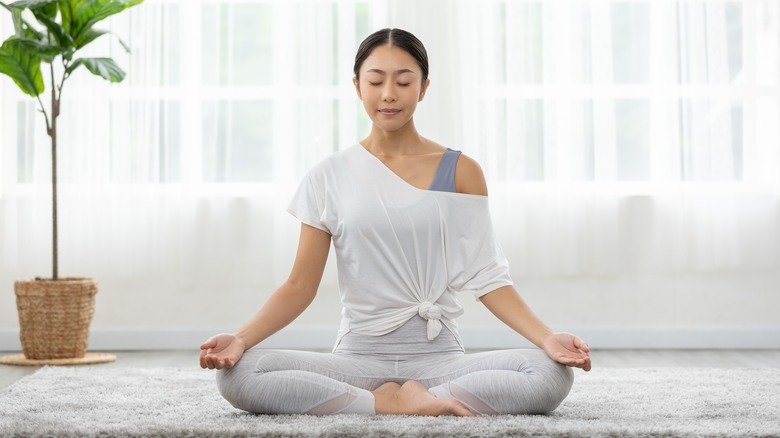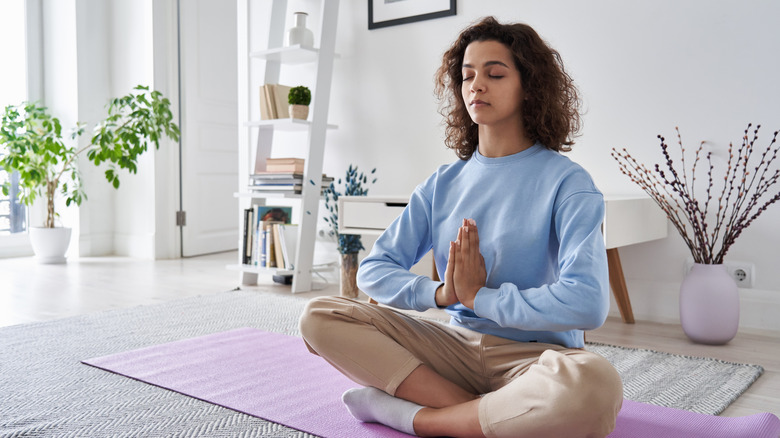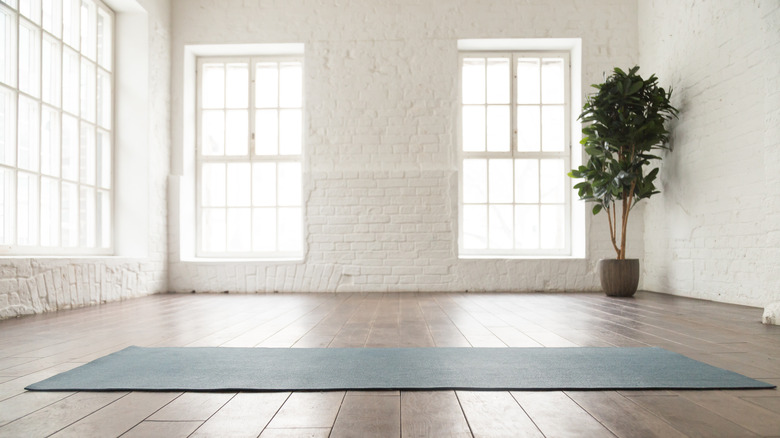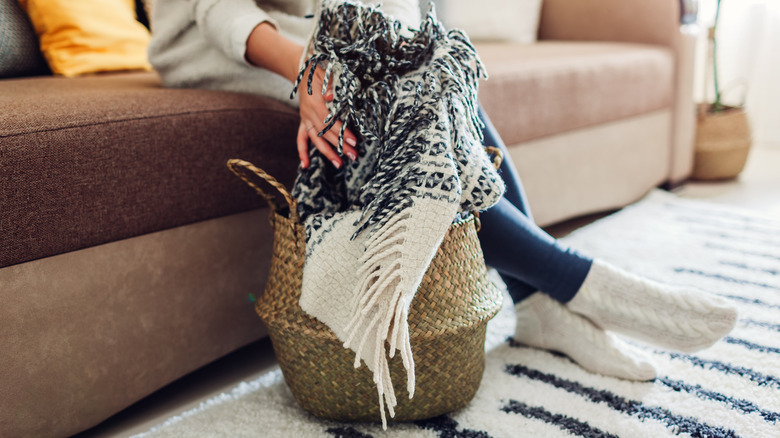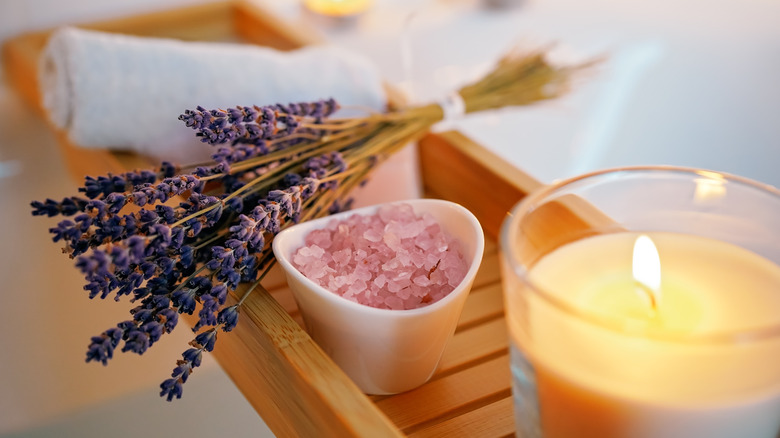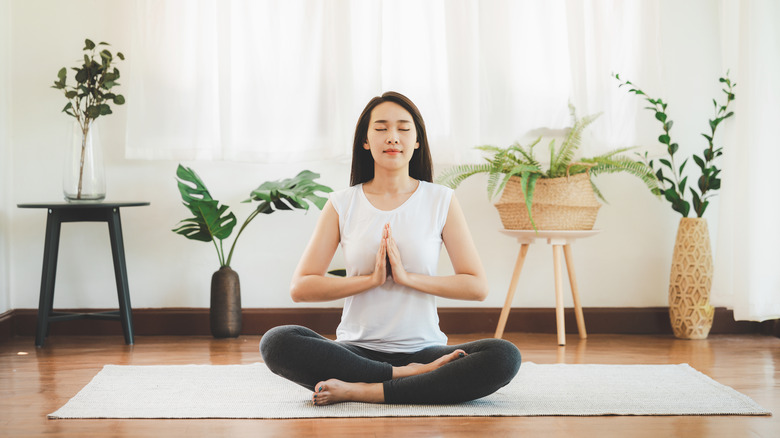How To Create The Perfect Meditation Room In Your Home
Regular meditation practitioners can attest to the practice's benefits and positive effects on overall health and wellbeing. According to Forbes, meditation can improve concentration, ease symptoms of depression and anxiety, aid in kicking addiction, and improve overall brain health. The hard part of reaping those benefits is building a consistent habit, but one option is to create a space in your home specifically designed for practicing meditation. In doing so, you will not only inspire yourself to meditate but be excited to do so. Before you know it, this daily practice will become second nature.
Because there are so many barriers to meditation, having a special place helps remove some of them. Your body and neural network will learn that this is when they settle down for a moment and go within if you sit down in the same spot at or around the same time every time, explains meditation expert Ralph De La Rosa (via AARP).
Choose a location
While considering a location for your meditation space, try to choose a spot that makes you feel calm and happy. This may mean something different from person to person. Perhaps the quietest and most isolated room in your home or the spot with the best natural light makes you feel the most serene. If you (understandably) don't have an extra room to spare, you could try using a room divider, setting up in a quiet corner, or even tucking into a closet or venturing to an outdoor spot, as AARP suggests.
In regards to lighting, natural is best. If your chosen room doesn't get the best light, consider using candles or another warm-hued accent lighting to create a serene atmosphere. However, if the sunlight is overbearing, a gauzy curtain will help diffuse it to set the perfect tone. If it's impossible to find a quiet space in your home, employing a white noise machine may be your best bet. No matter where you choose to set up, the bottom line is that it is a place in which you can achieve a sense of peacefulness.
Cut the clutter
One of the greatest benefits of dedicating an entire room to meditation is the opportunity to remove distracting clutter and be incredibly picky about the items that you bring into the space. The result is a stress-free oasis that makes it easy to focus on meditating. Clutter will have us feeling more disorganized in our minds, NewsGP notes; therefore, you'll want to eliminate objects that remind you of work, tasks on your to-do list, and anything else that demands focus and attention.
Gaiam suggests also removing all technology and screens from the space and using a Bluetooth speaker (with your device outside the room) if you rely on a meditation podcast or white noise. Since screens are designed to grab your attention, you will already feel more focused and peaceful by taking them out of the equation. Even a phone placed face down can become a distraction, as it presents the temptation to check it and serves as a visual cue of things like our calendars, work, and social obligations.
Comfort is key
Creating a comfortable environment is the most significant concern in deciding what to include in your meditation room. Make sure you have a cozy spot to sit while meditating, whether it be a yoga mat, cushion, chair, or whatever else works best for you and the space. For example, if you meditate on the floor, Tint says propping up your hips by sitting on a cushion or rolled-up blanket will help relax your knees and hips.
Calm Moment recommends including a variety of soft textures, such as cushions, blankets, mats, and sheepskins. They also suggest that if your meditation setup can't be a permanent fixture, store these items in a basket when not in use. As a bonus, the basket will invite you to begin your meditation practice whenever you see it. To further the effect, choose items in color schemes that make you feel both happy and calm. Often, this will be a neutral palette that mimics shades found in nature and helps cut the visual chaos.
Incorporate aromatherapy
Stimulating your senses can further enhance your meditation experience. The calmer you feel in your meditation room, the easier it will be to clear your mind and focus on your practice. According to Healthline, the use of aromatherapy can alleviate feelings of stress or anxiety, making it a powerful tool that may help invite a sense of calm to the space. Also, consider stocking the room with incense, candles, or essential oils in scents that makes you feel at ease.
If you'd like to take it a step further and inspire your taste buds as well, Gaiam recommends bringing a fresh cup of hot tea or lemon water to accompany you during your practice. Feel free to get creative with additional sensory objects that also appeal to you. For example, anything that makes you feel calm can be useful in your meditation room, as long as you don't go overboard and invite clutter. Small visual mementos or photos that make you content when you see them could decorate one corner of the space, for example.
Add the final touches
By now, your meditation space should be functional and serene, but it could likely benefit from a few final touches to make it feel like your own. Infusing the area with elements of nature can help make it feel complete, so try decorating the room with a couple of favorite potted houseplants or fresh flowers. In addition to ushering in the calming effects of the outdoors, plants can improve the air quality. Gaiam suggests including a beautiful landscape photo or botanical printed items in your meditation space as alternative ways to harness nature's soothing qualities.
Finally, personalize the area by creating a small shrine or thoughtfully placing small objects that are meaningful to you somewhere in the room. Doing so will invoke a stronger sense of ownership and commitment to the space, which will help you stay faithful to your meditation practice. As a bonus, AARP suggests that you can take a small piece of the room with you when you travel, such as a crystal or a photograph, to help ground you when meditating away from home.
